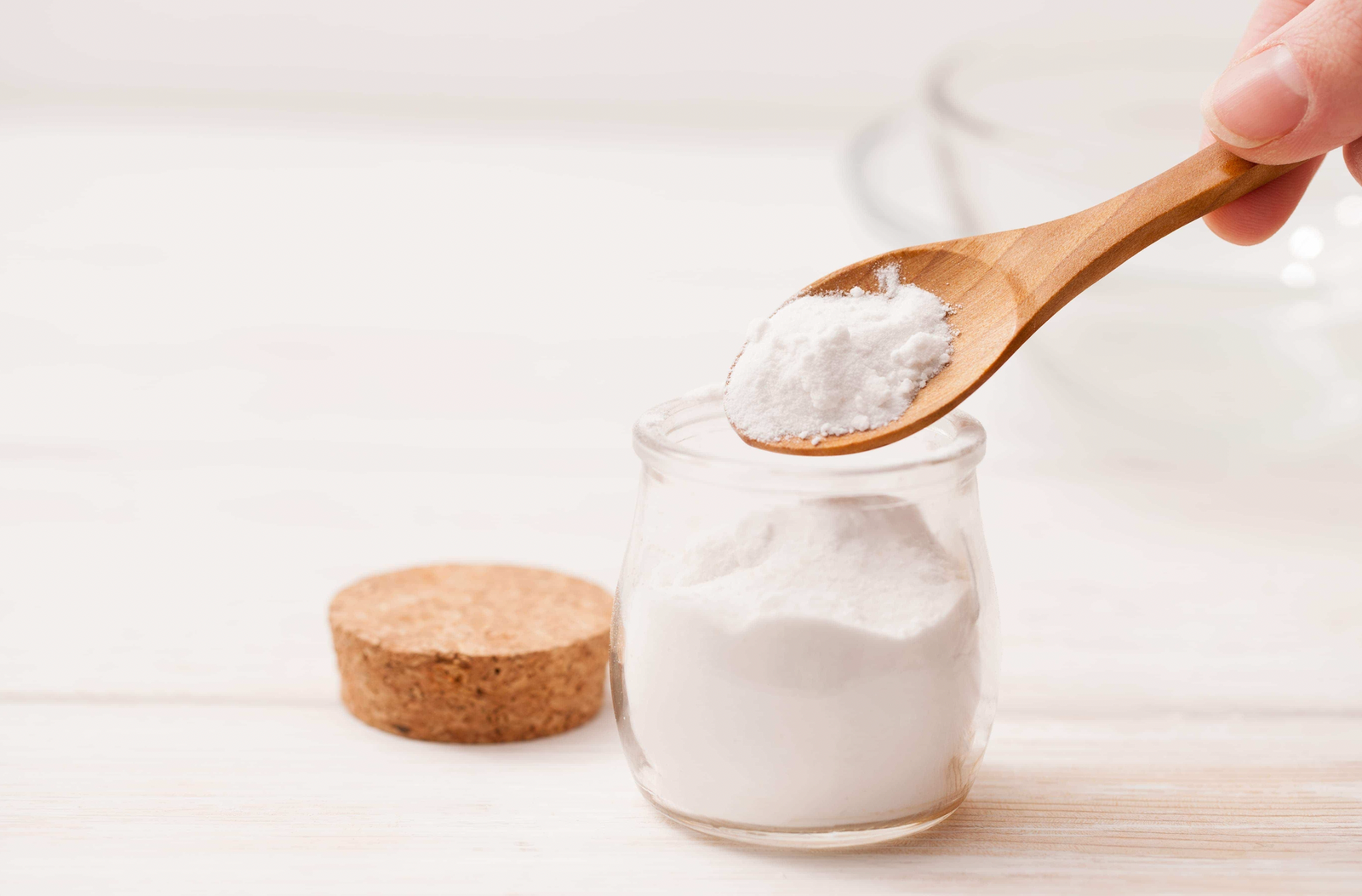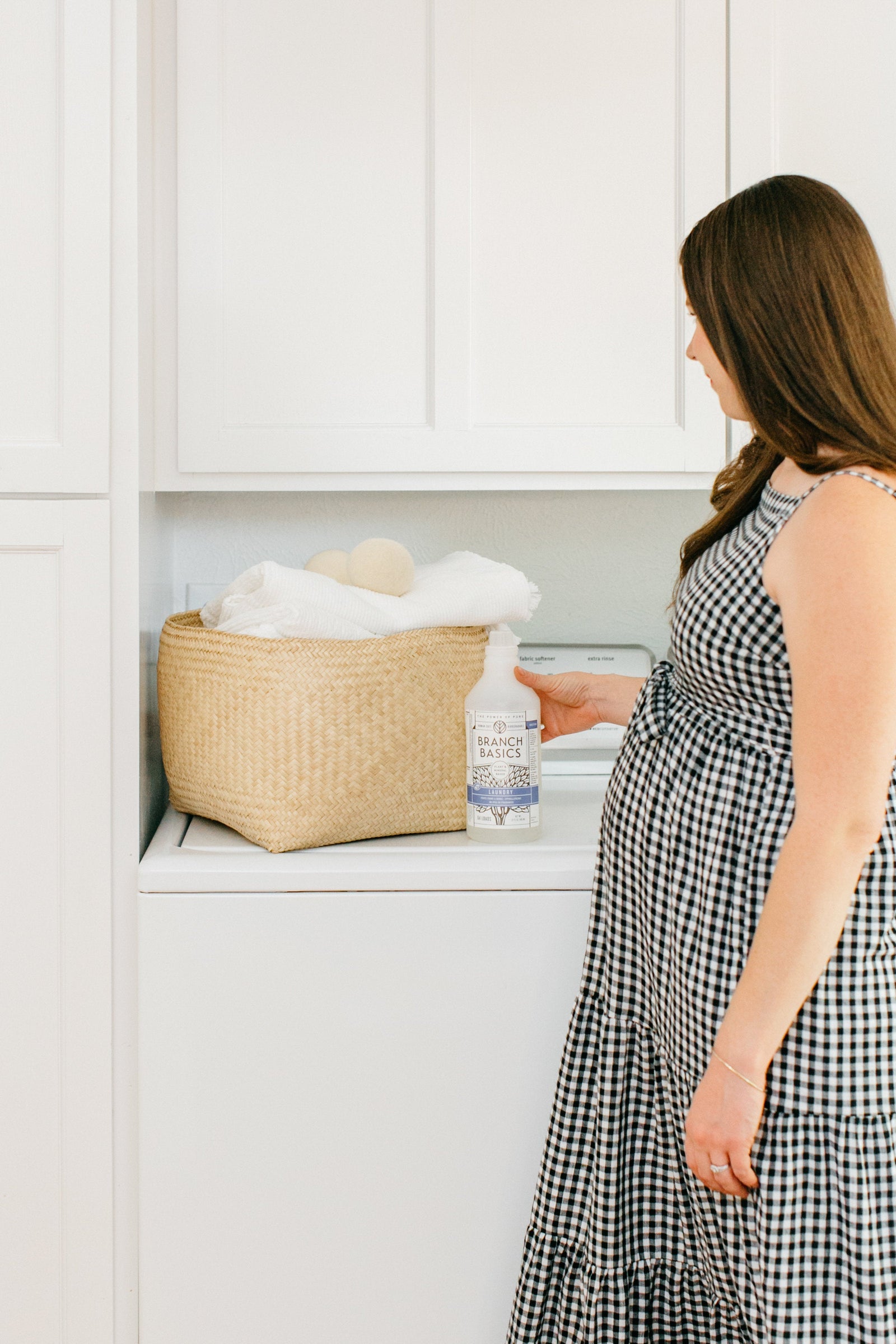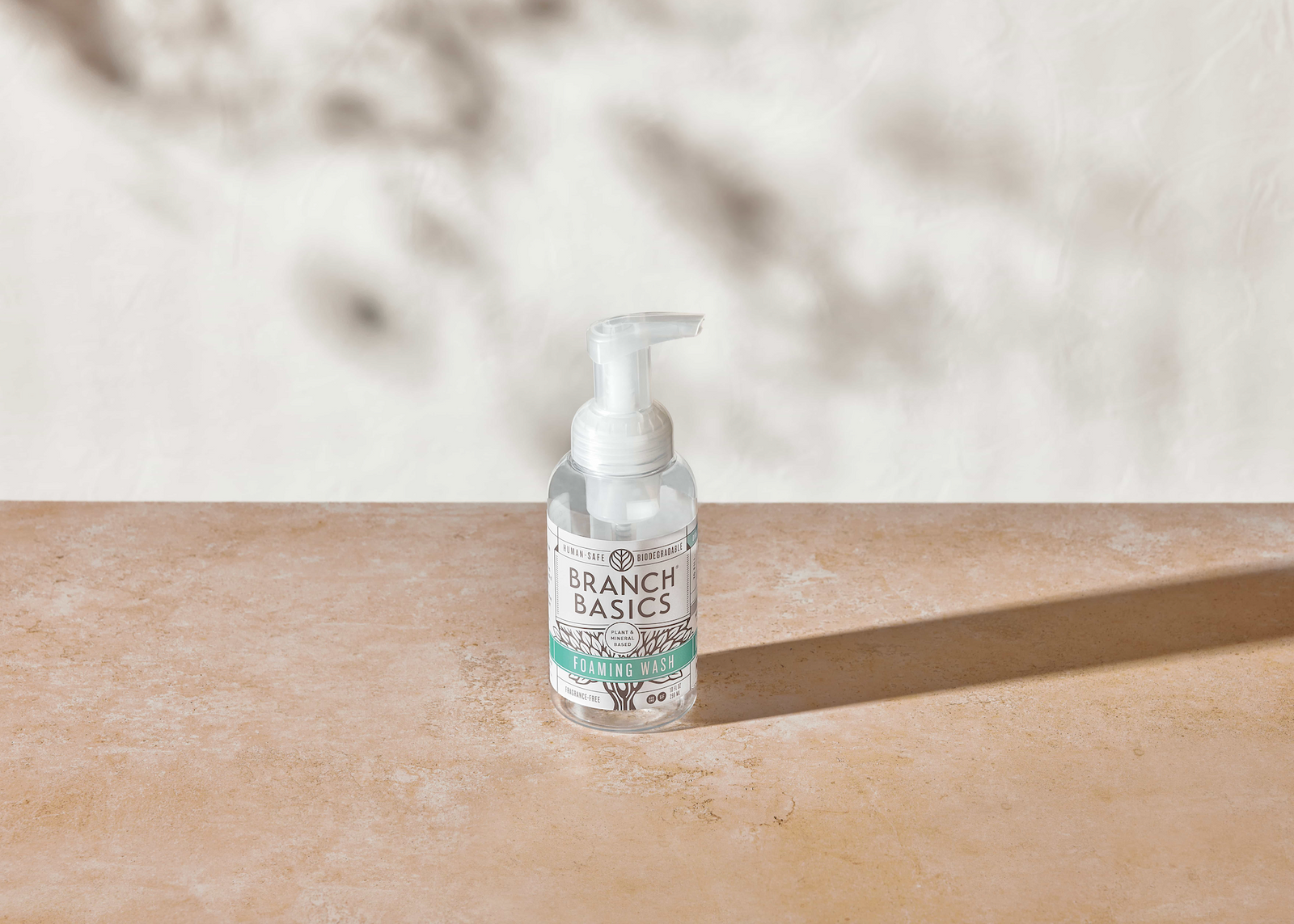Cleaning With Baking Soda (Sodium Bicarbonate): 12 Surprising Uses

Baking soda, also known as sodium bicarbonate, is a staple in most American homes. Its most common uses are as a leavening agent in baked goods, and in refrigerators to keep odors at bay.
However, this simple and natural salt also works as a powerful non-toxic cleaning agent, personal care ingredient, laundry booster, detoxification agent, and much more.
It truly is one of nature’s most versatile, inexpensive, and under-appreciated household products.
Read on to learn about baking soda and 12 ways you can use it to create a healthier home and body.
12 Uses for Baking Soda Around the House
1. Bathroom Tile Cleaner
Baking soda’s mild abrasive properties coupled with its whitening power, make it ideal for cleaning bathroom tile.
To use, make a paste with baking soda and water or baking soda and a bit of liquid castile soap or Branch Basics Concentrate. Apply with a tile scrub brush, and rinse.
2. Stain Remover
Sodium bicarbonate’s absorbent and whitening qualities make it an effective stain remover.
There are many ways to go about this, but a good spot cleaning method for clothing is:
- Make a paste of baking soda and a few squirts of Branch Basics Concentrate.
- Use a scrub brush to apply to the stain. Let dwell for at least 30 minutes.
- Blot up with a cloth and repeat if necessary. When the stain is mostly gone, launder as usual.
You can also soak larger stained items in a basin of water with half to 1 cup baking soda. Then launder as usual.
3. Grout & Mold Cleaner
Most of us have been taught that mold and mildew must be cleaned with bleach.
However, did you know that is no longer recommended by the EPA or OSHA? That’s because bleach only kills surface mold, leaves dead mold on the surface, and does nothing to prevent it from coming back.
The first step for removing mold is to clean the surface with soap and water like Branch Basics. That is all you need if you have a non-porous surface.
If you have a surface that has become discolored and needs to be lightened up, then 3% hydrogen peroxide can be used …and it works even better when combined with baking soda!
Here’s how:
For lifting mold and mildew stains on grout, shower tiles, etc., combine baking soda and peroxide and apply to the surface. Let sit a few minutes and remove with a stiff toothbrush or grout cleaning brush.
No baking soda on-hand? You can also combine Branch Basics Concentrate with Oxygen Boost and hydrogen peroxide to effectively lift mold and mildew stains.
4. Produce Cleaner
With the growing awareness about the harms of synthetic pesticides, plus recent E. Coli outbreaks it’s a really good idea to wash all your fruits and vegetables thoroughly.
It’s also important to buy organic and/or naturally grown as much as you’re able. But, when you can’t, follow these steps:
A recent study found that soaking conventional apples in a mixture of baking soda and water for 12-15 minutes, removed nearly all of the pesticides on the apple’s skin.
Branch Basics All Purpose, distilled white vinegar, or hydrogen peroxide can also be used as effective produce cleaners.
Read More: How to Naturally Clean Fruits and Vegetables
5. Toothpaste
Most teeth whiteners are full of toxic chemicals that are no good for your teeth (or your body) in the long-run.
Fortunately, sodium bicarbonate is a safe and effective natural teeth whitener.
To use, sprinkle a little mound of baking soda on your toothbrush. Add a bit of water, and gently brush your teeth. Rinse, and follow by brushing with your favorite all-natural toothpaste.
If using straight baking soda is too unappealing (baking soda is very salty!), you can add it to your regular toothpaste and use it that way.
6. Detox Baths
Detox baths are a best-kept secret for enhancing detoxification and promoting deep relaxation.
One of our favorites is a Salt and Soda Soak, which utilizes the alkalizing power of baking soda to help neutralize the acidifying effects of ionizing radiation.
Thus, it’s a great bath to enjoy after air travel, medical scans, x-rays, or any other type of radiation exposure.
All you need is 1-2 pounds of plain old table salt and 1-2 pounds of baking soda, a bathtub, and some hot water.
Get the full recipe here: Salt and Soda Soak: A Radiation Detox Bath
7. Laundry Stripping
Laundry stripping is a process that removes built up dirt, grime, fragrance, and residues from clothing by soaking clothing in a mixture of detergent and boosters.
The synthetic chemical-free method involves soaking laundry in a mixture of hot water, Branch Basics Laundry Kit, and Baking Soda.
For step-by-step instructions, see: Human-Safe Laundry Stripping With Branch Basics.
8. Dry Shampoo
As working moms, we know how hard it can be to get a shower every day…let alone a shower that involves hair washing.
Dry shampoo to the rescue!
An easy DIY recipe is to use equal parts baking soda and cornstarch (which are both oil absorbent) and apply directly to your hair.
We love this recipe from No Waste Nutrition which has recipe variations for different hair colors.
In addition, you can also use baking soda to make a makeshift non-toxic wet shampoo. Just combine 1-2 tablespoons of baking soda with water and massage it into your scalp. Rinse and condition as usual.
9. Cleaning Hair Brushes and Combs
Baking soda’s absorbent and deodorizing properties make it perfect for cleaning brushes and combs.
Here’s how:
- Remove hair from your brush or comb.
- Prepare a solution of 2-3 tablespoons of baking soda with 3-4 cups of hot water in a large basin (or your sink). Stir to dissolve the baking soda.
- Soak your brush or comb for 30 minutes.
- Scrub with a bottle brush or old toothbrush to remove build up.
- Rinse and let dry.
You can also use this solution to clean makeup brushes, sponges, and other applicators.
10. Multipurpose Kitchen Cleaner
Baking soda is a powerful cleaning weapon in the kitchen.
Some of our favorite ways to use it include:
- For scouring sinks
- Cleaning cutting boards
- Cleaning the coffee maker
- Deodorizing our fridges, trash cans, garbage disposal, and compost bins
- Cleaning the stovetop (Concentrate + Oxygen Boost works great for this too)
- Deep cleaning the dishwasher
- Remove stuck-on or burnt-on food from pots and pans (boil water with baking soda directly in the pot for a few minutes, scrub and rinse)
For more kitchen-cleaning tips, check out: Best Human-Safe Kitchen Cleaning Tips for 2023
11. Unclogging Drains
Drain cleaners are some of the most toxic and poisonous cleaning solutions in the American household - read more about that in The Most Toxic Cleaning Products To Avoid & Safe Swaps.
You can also dissolve clogs by adding baking soda and distilled white vinegar to your drain. Let sit a few minutes, then rinse with very hot water. Repeat until the clog is dissolved.
12. As a Natural Deodorant
If you think natural deodorant is ineffective then you’ve been using the wrong stuff.
To learn our favorite brands and get our popular DIY baking-soda-based recipe, check out: How to Detox Your Armpits And Switch To A Non-Toxic Deodorant & Simple DIY Personal Care Product Recipes.
What Should You NOT Clean With Sodium Bicarbonate?
Since sodium bicarbonate is mildly abrasive, you should avoid using it on scratchable surfaces such as glass, ceramic cooktops (and cookware if scrubbing), marble, wood, wood floors, quartz, gold and silver.
It’s also not good to use on aluminum pots (which we hope you’re not using anyway!) or anything with cracks or grooves where it can settle.
Final Thoughts on Using Baking Soda Around the House
Sodium bicarbonate is a must-have for natural cleaning, personal care, and so much more. In fact, we use it so much we buy it in bulk from our local price club.
Plus, it also makes a great complement to the Branch Basics line of cleaning products and human-safe cleaning methods.
To learn more about human-safe cleaning solutions, strategies, and must-have products check out our Toss The Toxins Online Course and the Cleaning section of our blog.

Marilee Nelson
Marilee Nelson is an Environmental Toxins expert who has spent nearly 30 years advocating for the chemically-sensitive and chronically-ill. She is a Board Certified Nutritionist, Certified Bau-Biologist and Bau-Biology Inspector and specializes in Food As Medicine. She has helped thousands of families and individuals identify, heal and recover from toxic exposures and is on a mission to revolutionize the way American families view their health.








